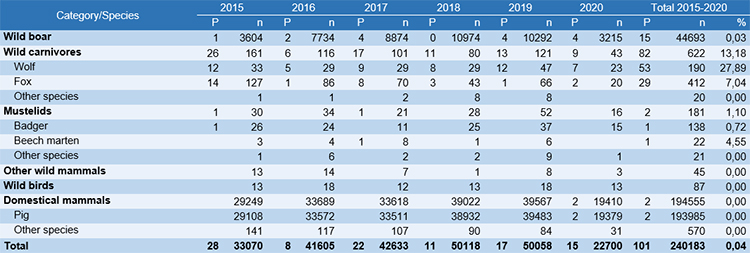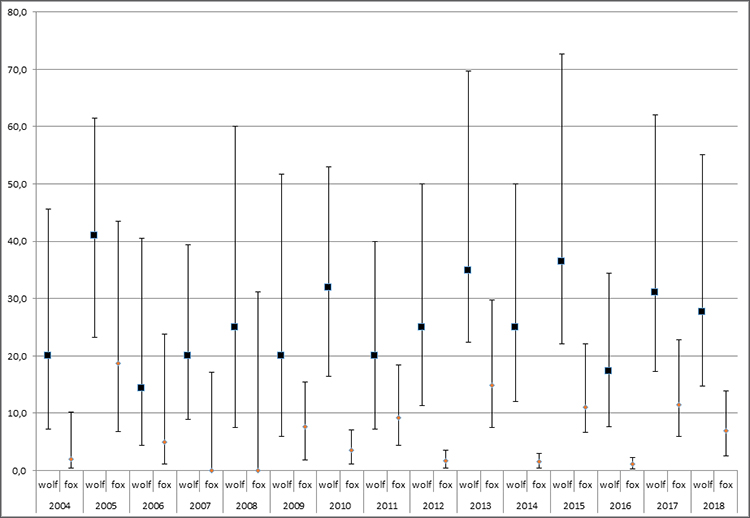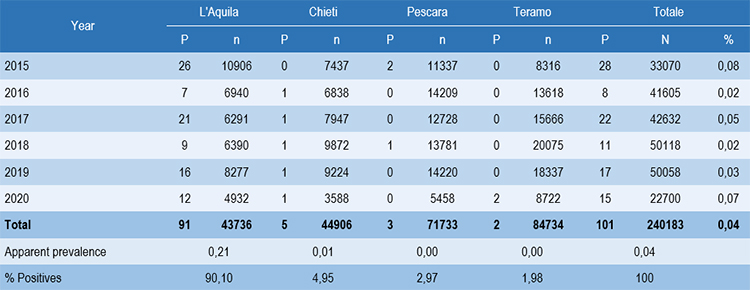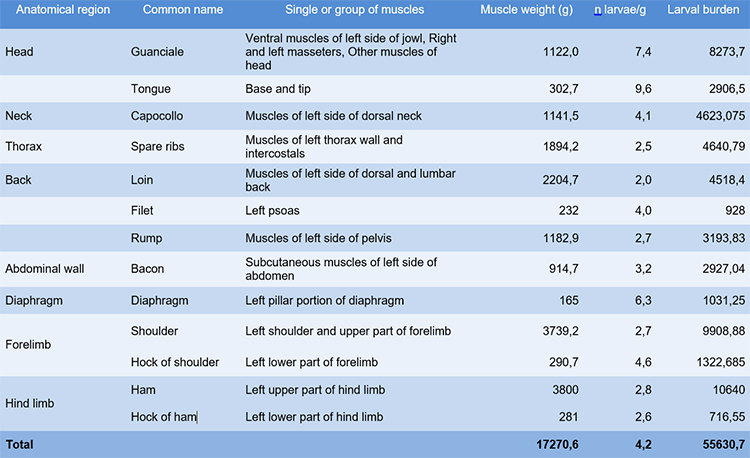Spread of Trichinella britovi in domestic animals and wildlife in the Abruzzo region
Introduction
The Trichinella genus includes 12 taxa which are divided into two clades, one including six species (T. spiralis, T. nativa, T. britovi, T. murrelli, T. nelsoni and T. patagoniensis) and three genotypes (Trichinella T6, T8 and T9) that encapsulate L1 larvae in the somatic striated muscle of their hosts where they mature into their infectious stage. The second clade instead includes three species (T. pseudospiralis, T. papuae and T. zimbabwensis) that infect their hosts without cystic transformation (non-encapsulated species). All species can parasitize mammals, T. pseudospiralis also birds and T. papuae reptiles as well [1]. Currently, wildlife represents the largest reservoir of the parasite, which is transmitted among wild species through carnivorism both in the predator-prey form and through necrophagic behaviour.
Synanthropic sensitive animal species, semi-wild or wild breeding and the abandonment of carcasses or slaughtering remains are determining factors for the establishment of domestic cycles of infection. The disease in humans is associated with the consumption of raw or undercooked or insufficiently seasoned contaminated meat products.
The circulation of Trichinella in Europe is supported by four species: T. spiralis, T. pseudospiralis, T. nativa e T. britovi. In Italy, with the exception of sporadic reports of sylvan cycles sustained by T. spiralis and T. pseudospiralis, T. britovi is the species that supports the sylvan cycle.
The fox is considered the reservoir of T. britovi in the Alpine regions, while in the Apennine regions the parasite is found mainly in wolf (Canis lupus italicus), in fox and less frequently in wild boar and mustelids [2, 3, 4, 5].
In a previous study relating to the period 2004-2014, an apparent prevalence (PA) of 0.51% of T. britovi infection was found in the Abruzzo region. In this study no infection was found in domestic species intended for human consumption. Samples tested came from the territory of 265 of the 305 municipalities of the four Abruzzo provinces, and no positivity was detected in the Province of Teramo [3].
The purpose of this work is to provide updates regarding the distribution of T. britovi infection in the territory of the Abruzzo region and in host species in the period 2015-2020 (until 30th June). In particular, to report data from two recent infection events in a previously unaffected species and territory.
Epidemiological situation of T. britovi infection in the Abruzzo region in the period 2015-30 June 2020
In the considered period, samples coming from regional health monitoring plans for wildlife, wild boar selective killing plans and official control of meat of species intended for human consumption were tested for Trichinella using the enzymatic digestion methods prescribed by the European Regulation 1375/2015 [5].
Altogether 101 isolates of Trichinella spp were obtained from these activities (Table 1) and no species other than T. britovi was identified by the European Reference Laboratory for parasites located at the Istituto Superiore di Sanità in Rome, to which they were sent for species identification [6].
Table 1. Samples examined in the period 2015-2020 (as of 30.6.2020) for Trichinella, divided by category or species

P: positive; n: number of samples examined
The AP of the infection decreased overall (from 0.51% to 0.22%) compared to the period previously considered (2004-2014). While AP data regarding wild carnivores and the sporadicity of the wild boar and mustelids infection were confirmed. The analysis of the historical series of the prevalences found in wild carnivores (Figure 1) shows how the infection prevalence in the wolf is, almost constantly, above the confidential upper limit of the prevalence in the fox.

Figure 1. Apparent prevalence of T. britovi in wild carnivores in the period 2004-2018 in the Abruzzo region
However, in the considered period, two recent positive events changed the historical trend of the infection in animals; the first outbreak of Trichinella in domestic pigs was recorded in the Abruzzo region and, for the first time, infection in wild boars hunted in the province of Teramo was detected (Table 2).
Table 2. Samples examined in the period 2015-2020 (up to30.06.2020) for Trichinella, divided by province of origin

P: positive; n: number of samples examined
First outbreak of T. britovi in pigs in the Abruzzo region
January and February 2020, two pigs subjected to regular slaughter tested positive for T. britovi. The animals came from a closed-cycle semi-wild pig farm in the province of L'Aquila on the border with the Lazio region, conducted on a fenced plot of approximately 34 hectares, in an agricultural-forest area.
On January 2020, the consistency of the farm was 79 pigs, mainly fatteners, with the presence of 7 breeders. The mixed breed pigs were derived from crossing between duroc, cinta senese, landrace and large white. Until 30 June 2020, another 7 pigs from the farm were slaughtered and tested negative for Trichinella. In addition, two other pigs that died on the farm and one captured mouse were subjected to the search for Trichinella, also with negative results.
One of the half carcasses of the two positive pigs, together with the whole head of the same animal, were subjected to a boning protocol in order to estimate the overall larval load. For this purpose the side was cut into 13 cuts corresponding to the main commercial cuts of pork processing. These, together with the recognized predilection sites for the encystation of larvae (tongue, diaphragm, masseters), were subjected to the search for Trichinella. The number of larvae per gram of each muscle group was determined and, by multiplying the latter by the respective weight, the larval loads of the individual districts were estimated. Finally, by adding the latters, the larval load of the entire half-carcass was estimated (Table 3).
Table 3. Distribution of the larval load of the pig side

First outbreaks of T. britovi in wild boar in the province of Teramo
Between May and June 2020, the presence of T. britovi larvae was detected in two wild boars killed as part of the selective control program of the species. The animals came from two locations on the eastern side of the Mount Gran Sasso in the province of Teramo, about 40 km apart. Regarding the origin of these first findings of the infection in wild boar in the Teramo area, the most likely hypothesis is the arrival of parasitized wild boars through natural corridors existing between these localities of the Mount Gran Sasso and the territories of Chieti and Pescara provinces. In these territories parasitized wild boars were found sporadically in the years 2014, 2016, 2017 and 2019.
Considerations
The outbreak of T. britovi in swine in the province of L'Aquila in 2020 can be considered the first case of spillover in this species in the Abruzzo region. In fact, from the health archives of the Istituto Zooprofilattico Sperimentale dell’Abruzzo e del Molise (IZSAM), there are no positive results in this species.The infected farm belongs to the type most exposed to Trichinella infection in consideration of the environmental sharing of animals with multiple wild species that are potential reservoirs of the parasite.
The study of the larval load has shown that natural T. britovi infection in swine is ubiquitous and reproduces what is found in experimental infections [7].
The predilection sites (head muscles, tongue, diaphragm) were the most parasitic, confirming the diagnostic validity of laboratory screening. Finally, the presence of at least 2 larvae/g even in commercial cuts intended for charcuterie products strengthens the indications on the risk of parasite transmission through uncontrolled pork meat preparations, eaten raw or not sufficiently seasoned.
References
- Pozio E., Murrell K. 2006. Systematics and epidemiology of Trichinella. Adv Parasitol., 63:367-439
- Pozio E. 2019. Trichinella and Trichinellosis in Europe. Veterinarski Glasnik, 00, 1-20
- Badagliacca P., Di Sabatino D., Salucci S., Romeo G., Cipriani M., Sulli N., Dall'Acqua F., Ruggieri M., Calistri P., Morelli D. 2016. The role of the wolf in endemic sylvatic Trichinella britovi infection in the Abruzzi region of Central Italy. Vet. Parasitol., 231:124-127
- Remonti L., Balestrieri A., Domenis L., Banchi C., Lo Valvo T., Robetto S., Orusa R. 2005. Red fox (Vulpes vulpes) cannibalistic behaviour and the prevalence of Trichinella britovi in NW Italian Alps. Parasitol. Res., 97:431-435
- Commissione Europea. 2015. Regolamento di esecuzione (UE) 2015/1375 della Commissione del 10 agosto 2015 che definisce norme specifiche applicabili ai controlli ufficiali relativi alla presenza di Trichine nelle carni. Gazzetta Ufficiale, L 212, 7-34
- Kapel, C.M.O., 2005. Muscle distribution of sylvatic and domestic Trichinella larvae in production animals and wildlife. Vet. Parasitol., 132, 101-10.
Stefania Salucci*, Nadia Maria Sulli* , Antonio Melideo**, Marco Gargano**, Nicola Pisegna Orlando**, Luciano Marini***, Pietro Badagliacca*
* Istituto Zooprofilattico Sperimentale dell'Abruzzo e del Molise "G. Caporale" (IZSAM)
** Azienda Sanitaria Locale 1 Avezzano Sulmona L’Aquila, Dipartimento di Prevenzione, Avezzano
*** Azienda Sanitaria Locale Teramo, Dipartimento di Prevenzione, Teramo